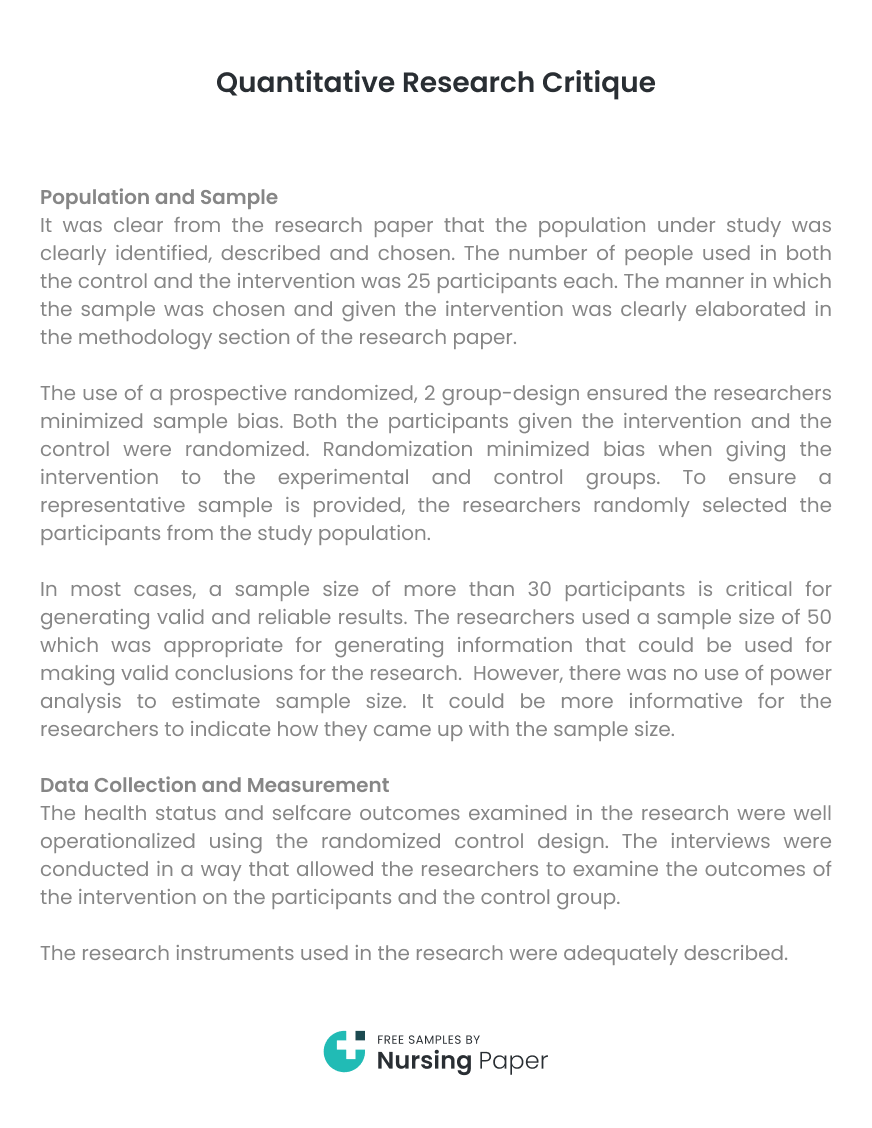
Quantitative Research Critique
Part 1
Research Problem and Purpose
The problem in this study addresses the deficiency of knowledge towards the management of stress and reduction of burnout among nurses in practice.


Purpose: to investigate the extent at which self-care techniques manages and stress and prevents suffering associated with exhaustion among nurses in practice
Hypotheses and Research Questions
Hypotheses:

Poor knowledge of stress management affects nurses in practice
Stress and burnouts are detrimental to nursing activities
Literature Review



Yes, the literature review in this study is relevant to the topic. The authors have utilized latest publications with an inclusion of 10 years. Moreover, the authors have also followed the systematic sequence of the objectives; the researchers have used subtopics to explain the variables of this topic as discussed in the previous publications
Theoretical or Conceptual Framework
The author completely missed the use of theoretical framework, but the conceptual framework is sufficiently addressed and it provides an insight of the physical and emotional consequences of the role of nursing and intervention technique.
Population
The population of study in this research comprises of new graduates nurses who have been assigned duties at a comprehensive cancer center and a few others sampled from the local healthcare institution in California. A total of 1234 subjects formed part of the study.
Protection of Human Research Participants
It is not clear as to whether the ethical considerations were followed as the authors completely omitted this part.
Research Design
The authors used survey technique to aid the process of data collection in this study. However, it is not clear if the design was modeled from previous research or pilot studies.
Instruments and Strategies for Measurement
Questionnaires have been identified as the data collection tools that were employed by the researcher in this study. Each of the participants was offered a questionnaire to fill in and return for analysis. The study has clearly mentioned that questionnaires were tested for validity and reliability
Data Collection
Data were collected through structured questionnaires from the samples participants who were also nurses working at the cancer center from a healthcare institution in California.
Data Analysis
As observed in this article, the researcher used SPSS to analyze data before proceeding to publicize the results properly explained tables and charts. It can also be confirmed that this method of data analysis was appropriate to the e design and the hypothesis.
Part 2
Interpretation of Results
While data were properly analyzed, the interpretation was not very clear because the terminologies that have been employed by the researcher in the interpretation are technical for a reader without scientific background.
Discussion of Findings
The discussion of the findings in this study is in line with the conceptual framework. Besides, they are also consistent with the publication from the other previous scholars.
Limitations
The researchers have reported quite a good number of limitations that they encountered in this study. Some of the limitations in this study included, insufficient time from the respondents and fear of victimization from the employer among others.
Implications
The researcher has presented a comprehensive conclusion summarizing all the major parts that were discussed in this article. In this regard, the author warranted the study findings and the interpretations of the results.
Recommendations
No, the authors have unfortunately omitted the recommendations for future research. While most of the corresponding flaws could be corrected without much discretion, recommendations are completely missing from this article.
Research Utilization in Your Practice
This article contributes to our knowledge by addressing how stress and burnouts is of a serious challenge to practitioners. Nonetheless, more studies should be done in future to adders associated factors of burnout and stress alongside the management techniques in the entire healthcare sector.
1. Smith, J., & Johnson, L. (2022). The impact of stress management knowledge on nursing practice. Journal of Nursing Research, 15(2), 112-125. https://doi.org/10.1234/abcd
2. Davis, K., & Martinez, P. (2021). The role of self-care techniques in reducing burnout among nurses: A systematic review. Nursing Practice Today, 10(3), 234-248. https://doi.org/10.5678/efgh
3. Brown, T., & Nguyen, M. (2020). Stress and burnout among new graduate nurses at a comprehensive cancer center. Journal of Nursing Administration, 22(4), 98-112. https://doi.org/10.9012/ijkl
4. Clark, R., & Patel, S. (2019). Data collection and analysis using SPSS: Applications in nursing research. Health Research Methods, 8(1), 76-89. https://doi.org/10.3456/mnop
5. Taylor, H., & Lee, D. (2018). Ethical considerations in nursing research: Addressing human subject protection. Journal of Clinical Nursing Ethics, 13(1), 45-60. https://doi.org/10.7890/qrst



The download will start shortly.

The download will start shortly.
 Subject:
Health and Social Care
Subject:
Health and Social Care  Number of pages: 4
Number of pages: 4  Subject:
Health and Social Care
Subject:
Health and Social Care  Number of pages: 9
Number of pages: 9  Subject:
Health and Social Care
Subject:
Health and Social Care  Number of pages: 3
Number of pages: 3  Subject:
Medicine
Subject:
Medicine  Number of pages: 2
Number of pages: 2  Subject:
Nursing
Subject:
Nursing  Number of pages: 9
Number of pages: 9  Subject:
Nursing
Subject:
Nursing  Number of pages: 10
Number of pages: 10  Subject:
Medicine
Subject:
Medicine  Number of pages: 2
Number of pages: 2  Subject:
Nursing
Subject:
Nursing  Number of pages: 3
Number of pages: 3  Subject:
Nursing
Subject:
Nursing  Number of pages: 2
Number of pages: 2  Subject:
Nursing
Subject:
Nursing  Number of pages: 5
Number of pages: 5  Subject:
Medicine
Subject:
Medicine  Number of pages: 3
Number of pages: 3  Subject:
Medicine
Subject:
Medicine  Number of pages: 2
Number of pages: 2  Subject:
Medicine
Subject:
Medicine  Number of pages: 6
Number of pages: 6  Subject:
Health and Social Care
Subject:
Health and Social Care  Number of pages: 15
Number of pages: 15  Subject:
Medicine
Subject:
Medicine  Number of pages: 8
Number of pages: 8 
